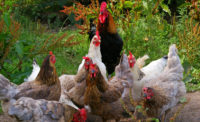As millions of Americans celebrate the Memorial Day weekend, grills will be firing up across the US. With the warm weather, more summer cookouts are right around the corner and USDA’s Food Safety and Inspection Service (FSIS) is urging consumers to remember the four simple steps to food safety - Clean, Separate, Cook and Chill - and to steer clear of the ‘danger zone’ while cooking outdoors.
“This Memorial Day weekend and all summer long, I encourage families to get outside and enjoy the great outdoors and the variety of food America’s farmers are able to provide,” says Al Almanza, deputy under secretary for food safety. “It’s important to remember that bacteria grow faster in the same warm temperatures, so extra care should be taken to make sure perishable food doesn’t spend too long in the danger zone. That is temperatures between 40 and 140˚F when perishable food spoils rapidly. Foods that should be served hot or cold should not spend more than one hour in the danger zone when temperatures are above 90˚F, and two hours when temperatures are below 90˚F.”
So just what is the danger zone?
The danger zone is the temperature range in which bacteria can grow faster. Bacteria can double in number in as little as 20 minutes when perishable food is kept in the Danger Zone. In order to steer clear of the Danger Zone, you should always:
Keep cold food, at or below 40°F, in the refrigerator, in coolers, or in containers on ice.
Limit the time coolers are open. Open and close the lid quickly. Do not leave coolers in direct sunlight.
Keep foods served hot at or above 140°F, in chafing dishes, warming trays, slow cookers or on the grill. You can keep cooked meats hot by setting them to the side of the grill rack, not directly over the coals where they could overcook.
Use a food thermometer to check the safe recommended temperatures.
Never leave food between 40 and 140˚F for more than two hours. If the temperature is above 90°F, food should not be left out more than one hour.
When preparing food for a cookout, FSIS recommends following four steps:
Clean: Make sure to always wash your hands and surfaces with soap and warm water for 20 seconds before cooking and after handling raw meat or poultry during cooking. Wash cutting boards, dishes, utensils, and work spaces with soap and warm water too. If you plan to be away from the kitchen, pack clean cloths and moist towelettes for cleaning surfaces and hands.
Separate: When taking food off the grill, use a clean platter. Don't put cooked food on the same platter that held raw meat or poultry. Any harmful bacteria present in the raw meat juices could contaminate safely cooked food.
Cook: Always use a food thermometer to check the internal temperature of burgers, steaks, chicken, and foods containing meat or poultry.
Hamburgers, sausages and other ground meats should reach 160°F.
All poultry should reach a minimum temperature of 165°F.
Fish should be cooked to 145°F.
Whole cuts of pork, lamb, veal, and of beef should be cooked to 145°F measured by a food thermometer placed in the thickest part of the meat, and allowed to rest for three minutes before eating. A “rest time” is the amount of time the product remains at the final temperature, after it has been removed from a grill, oven, or other heat source. During the three minutes after meat is removed from the heat source, its temperature remains constant or continues to rise, which destroys pathogens.
Meat and poultry cooked on a grill often browns very fast on the outside, and by using a food thermometer you can be sure items have reached a safe minimum internal temperature needed to destroy any harmful bacteria that may be present.
Chill: After a cookout, place leftovers in shallow containers and refrigerate or freeze immediately. Discard food left in the danger zone too long.



